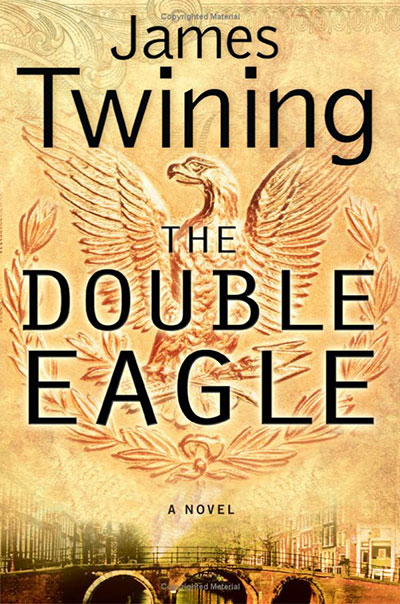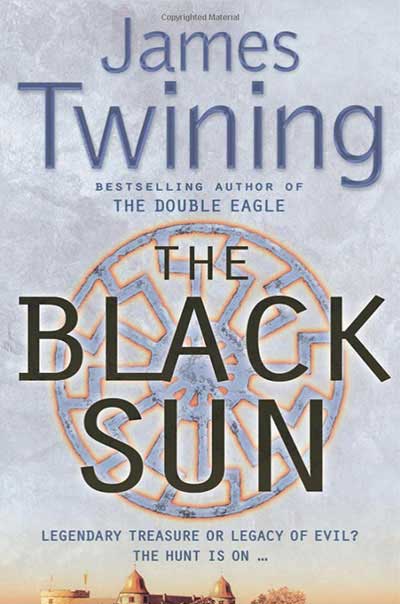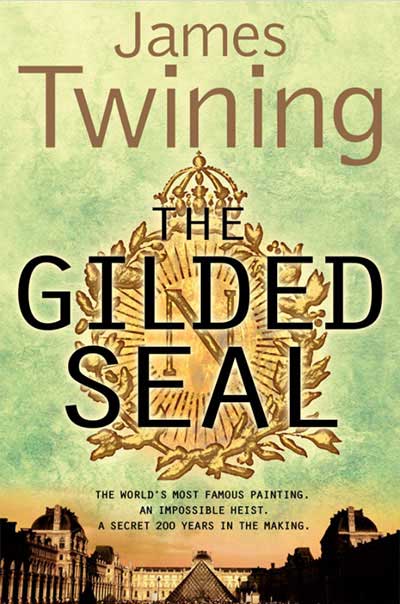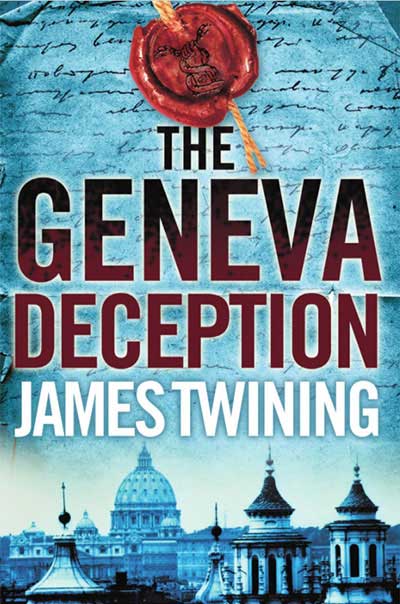Below you will find pictures and information on some of the beautiful works of art that populate The Double Eagle.
The Winter Egg by Fabergé – 1913

The Winter Egg is viewed as perhaps Fabergé’s finest creation. It was made for Tsar Nicholas II to give to his mother, the Dowager Empress Maria Feodorovna, for Easter in 1913 and was the most expensive egg ever commissioned.
The egg, cut from Siberian rock crystal is encrusted with more than three thousand diamonds, with another one thousand three hundred diamonds adorning the base. Engravings on the interior simulate ice crystals. The egg rests on a detachable rock-crystal base formed as a melting block of ice and applied with platinum-mounted rose-diamond rivulets.
The Easter ‘surprise’ common to all Fabergé’s eggs, is a platinum Easter basket decorated with flowers made from gold, garnets and crystals. The basket symbolises the transition from winter to spring.
Only twelve Fabergé Eggs have come up for auction in the last seventy years. This one sold at Christies on 19th April 2002 for $9.6 million to a private buyer, making it the most expensive Egg ever sold.
In The Double Eagle, this is the first Fabergé Egg that Tom is commissioned to steal from a seventeenth floor apartment in New York.
 The Pansy Egg – 1899
The Pansy Egg – 1899
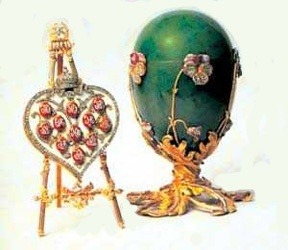
This Egg, presented by Nicholas II to Dowager Empress Maria Feodorovna in 1899 is made from tinted gold, diamonds, greenstone and violet enamel. It stands on golden leaves which twist up and from which sprout five flowers and five pansy buds enamelled in different shades of violet.
The top part of the Egg opens to reveal the “surprise”: a gold easel supporting a heart lined in diamonds and decorated with eleven scarlet medallions inscribed with individual monograms. A button releases tiny lids on the medallions to reveal miniature portraits of each member of imperial family.
This Egg is held in a private collection in the USA. In The Double Eagle, Tom Kirk steals this Egg from a private museum in Amsterdam.
Further information on the Fabergé Eggs
Carl Fabergé’s workshop created 50 eggs between the years 1885 and 1916 for Tsars Alexander III and Nicholas II, who presented them each year to the Empresses and Dowager Empress at Easter. Each egg was a unique masterpiece in its own right, constituting a tribute to Fabergé’s ingenious and exotic fantasies.
The Fabergé Easter tradition ended with the Bolshevik uprising, the disappearance of the Romanov Imperial family and their brutal slaying. In the chaos that followed, eight eggs disappeared and Stalin, viewing the eggs as symbolic of the worst Tsarist excesses, then authorised the piecemeal sale of the remainder to help finance his army. Most were sold to discerning American collectors.
Today, the largest single collection is held at the State Armoury Museum in the Kremlin, Moscow. The Virginia Museum of Arts has five, the New Orleans Museum of Art three and Her Majesty Queen Elizabeth II three. Only recently, the billionaire Russian industrialist Victor Vekselberg bought the entire Forbes collection of nine eggs. No price was disclosed, but pre-sale estimates were in the range of $80 million to $120 million. He has vowed to return the eggs to Russia.
 The Nile Sword – c.1798
The Nile Sword – c.1798
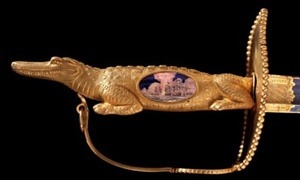
Admiral Lord Nelson (1758-1815) is Britain’s greatest ever naval commander. Even today, his battle tactics are studied at naval academies all over the world.
The “Nile Sword” is believed to have been presented to Nelson by Sultan Selim III following the Admiral’s stunning victory against the French in 1798. The sword carries an engraving of the destruction of the French flagship L’Orient and has a gilt crocodile-shaped hilt.
The sword was part of a collection which belonged to Nelson’s friend Alexander Davison and had remained hidden by his descendants for almost two centuries. It also included the blood-stained silk purse that Nelson was carrying when he was killed at the Battle of Trafalgar in 1805. The sword was sold at Sotheby’s in October 2002 for £336,650 (approx. $500,000).
In The Double Eagle, Tom is present at the auctioning of this item, although the dates have been changed.
Japanese Noh Mask – 1280
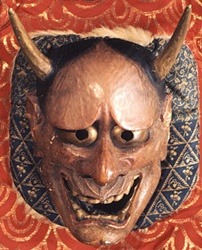
The origins of Noh theatre go back to thirteenth century Japan although it wasn’t until the seventeenth century that it was adopted as the official theatre of the Samurai class and the Shogun.
Noh theatre is characterised by its simple plots, elaborate costumes and its colourful masks. Masks are only worn by the main character, with each one caricaturing the type of person it represents and highlighting their essential traits and stylised emotions. Noh masks have to be very light because they are worn throughout a performance that lasts for several hours. They are carved from one piece of cypress wood and are comparatively small, covering the front of the face with only small holes for the eyes, nostrils and mouth.
There are five categories of Noh masks: gods, demons, men, women and the elderly. The mask pictured above dates from 1280 and features the character of Hannya, a once beautiful woman whose unrequited love has turned her into a monster consumed by jealousy and anger.
In The Double Eagle, Harry Renwick has a substantial collection of Noh masks.
Christ in the Storm on the Sea of Galilee by Rembrandt van Rijn – 1633
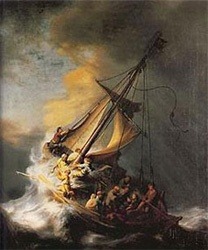
Rembrandt (1606-1669) was a Dutch baroque artist who ranks as one of the greatest painters in the history of Western art. Born in Leiden, he spent most of his working life in Amsterdam where he soon made his name painting portraits for wealthy patrons although his mythological and religious works were also much in demand. His paintings are characterized by luxuriant brushwork, rich colour, and a mastery of chiaroscuro which has perhaps never been equalled.
Today, he is especially known for the fifty or sixty self-portraits that he painted at various stages throughout his life that demonstrate a profound penetration of character and objective self-analysis.
Rembrandt also holds the dubious honour of being the most stolen artist ever. This priceless work – the only known seascape painted by Rembrandt – was stolen in the 1990 Isabella Stewart Gardener Museum heist in Boston, USA.
In The Double Eagle, Tom and Jennifer witness this painting being secretly auctioned in Istanbul.
The Concert by Jan Vermeer – 1665/6
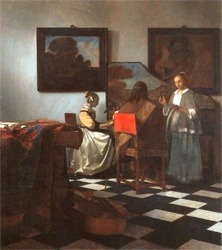
Johannes Vermeer (1632-75) was born and lived in the Dutch city of Delft. Overlooked for centuries, he is now regarded as one of the greatest painters in Western European art. His work is especially distinctive in its intimate portrayal of everyday life in Delft that masterfully combines light, colour, proportion and scale in a way that enhances the moods and reality of the subjects. His paintings also often contain a symbolical and allegorical content that further enhances their impact.
Only thirty six of his paintings survive, making Vermeer one of the world’s rarest and most collectable artists. In “The Concert” a man with his back to us plays a lute, a young woman plays the harpsichord and another sings. There are understated but powerful sexual tensions between the three of them.
In The Double Eagle, Tom and Jennifer witness this painting being secretly auctioned in Istanbul.
Further Information on the Isabella Stewart Gardener heist
The Isabella Stewart Gardener heist remains the largest robbery in US history. Two men dressed as Boston police officers talked their way inside, handcuffed and bound two guards, disarmed the alarm system and spent the next 81 minutes looting the place. They left with a Vermeer, three works by Rembrandt and five by Degas in a haul valued at over $300 million.
Even today, not a single painting has been recovered and not a single person arrested. The investigation continues and a $5 million reward has been offered. (Click here for more information.)
Giacometti sculpture
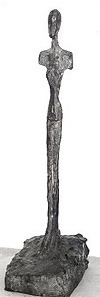
 Alberto Giacometti (1901-66) was a Swiss sculptor who, both because of the nature of his work and his close friendship with the French philosopher Jean-Paul Sartre, is the artist most closely identified with the Existentialist movement.
Alberto Giacometti (1901-66) was a Swiss sculptor who, both because of the nature of his work and his close friendship with the French philosopher Jean-Paul Sartre, is the artist most closely identified with the Existentialist movement.
The piece pictured above, only 12.6 inches tall, was stolen from the Kunsthalle exhibition centre in 2002. The thieves used a crowd of about 16,000 visitors on the centre’s extra “Long Night” when opening hours were extended until 3:00 a.m. as cover to swap the original bronze for a painted wooden figure. The theft was only discovered three days later.
In The Double Eagle, Tom and Jennifer witness this sculpture being secretly auctioned in Istanbul.

